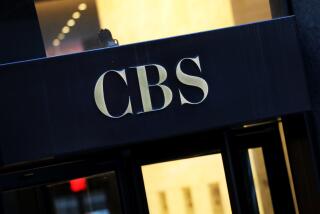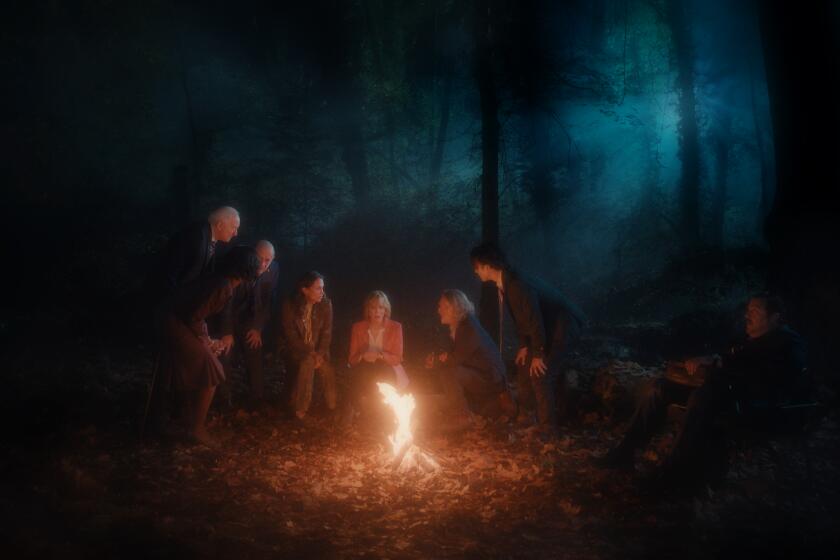Synergies Emerge in TV Duopolies
One in a series of occasional
reports on the media
ownership debate.
It was just supposed to be a football game -- and not a very important one at that. The Aug. 9, 2002, clash between the Oakland Raiders and the Dallas Cowboys was simply another exhibition game preceding the regular season.
Although the game had little meaning, the broadcast of it was anything but routine, marking a historic shift. It was the day local TV went from B.D. to A.D. -- from “before duopoly” to “after duopoly.”
In earlier times, the game’s 6 p.m. start time would have forced KCBS-TV Channel 2 to preempt or delay its regularly scheduled “48 Hours” at 8 p.m. But the newsmagazine aired at its regular time, albeit on a different station. Network management decided to move it to KCBS’ sister station, KCAL-TV Channel 9, which had just merged with KCBS under the ownership of Viacom Inc.
The move represented the first major synergy between the two stations. TV duopolies -- in which one company can own two stations in the same city -- have been allowed by federal regulators, with certain restrictions.
On Monday, the Federal Communications Commission is expected to approve rule changes that would make it easier for companies to own two, or even three, stations in the same market. Already, duopolies in Los Angeles have begun to change the way stations operate and what viewers see.
The merging of KCBS and KCAL is not the only duopoly in town. KTTV-TV Channel 11 and KCOP-TV Channel 13 are now owned by News Corp. KNBC-TV Channel 4 and Telemundo’s two Spanish-language stations, KVEA-TV Channel 52 and KWHY-TV Channel 22, are under the umbrella of General Electric Co.’s NBC.
Some industry observers fear that such pairing of stations will lead to homogenization of programming, diluting the diversity of programming while alienating viewers.
“Viewers have less choices than they had before in terms of the voices they had on television,” said Sylvia Teague, director of Reliable Resources for Broadcast Political Coverage, a project of the Norman Lear Center at the USC Annenberg School of Journalism. The project develops and distributes resources for news coverage.
Teague, a former news executive and producer at KCAL and KCBS, said: “The stations have become interchangeable, and there’s obvious blurring between the two. And with the joining together of the two newsrooms, there’s not a whole lot of original reporting.”
Newscasts that previously overlapped on KCAL and KCBS, and KTTV and KCOP have been moved so they do not directly compete. KCOP’s sole newscast, a long-standing one-hour program that competed with KCAL, KTTV and KTLA-TV Channel 5, was cut in half and moved to 11 p.m., replaced by reruns of “Frasier” and “Seinfeld.”
Reporters for KCAL and KCBS hold microphones with the names of the two stations on different sides. Even for the reporters, this can be confusing: While filing a May 12 live report on KCBS on a baby who had been shaken to death, reporter Michele Gile had her microphone flag turned to KCAL.
Management at the duopoly stations say that -- at least for now -- they are determined to maintain separate identities for the merged stations. Station executives say that the duopolies will be more obvious in the business practices than on the air.
“Yes, there will be crossover with reporters,” said Nancy Bauer Gonzales, news director for KCBS and KCAL. “But our operation is designed that way so that the main thing is we have access to as many resources as possible.”
Linda Breakstone, who covers politics for KCBS and KCAL, said she doesn’t have to alter most of her reports to fit the philosophy of either station. “There seem to be more opportunities to do longer stories than there used to be,” said Breakstone, who has covered politics on local TV for more than 20 years.
KNBC President and General Manager Paula Madison also said that distinct identities are key in the three stations she oversees. Unlike the KCBS-KCAL merger, there is no on-camera crossover between KNBC and Telemundo. The stations have separate studios and news teams.
“It’s not our intention to turn our station into KNBC en Espanol,” said Madison. “We serve different audiences and we don’t want to cannibalize each other’s viewership. But in terms of finance, engineering, human resources and business, we will be very much together.”
Don Corsini, president and general manager of KCAL and KCBS, said his stations may join up at some point with other Viacom companies such as MTV to produce shows. “We try to think about what would make the best business sense,” he said.
Over at the KTTV-KCOP joint operation, the duopoly idea is less about sharing programs than providing an extra outlet for News Corp.’s programming. The Los Angeles Dodgers, owned by News Corp.’s Fox, used to air on KTTV and Fox Sports West. But now, in part to avoid disrupting the Fox Network programming that airs on KTTV, KCOP has become “the home of the Dodgers.”
The newscasts on KTTV are straightforward in their approach to issues and news, in sharp contrast to KCOP’s newscast. Anchors Rick Garcia and Lauren Sanchez deliver the news while standing instead of sitting behind a desk, and their attire is fashionably casual. The major stories of the day lead the first part of the newscast, followed by a heavy concentration on features geared to younger viewers, accented by a soundtrack of techno music.
The different philosophies in the KTTV-KCOP duopoly and the KCBS-KCAL duopoly are tied to viewer reaction. Fox insiders say the KCBS-KCAL policy of cross-promoting and sharing resources may ultimately be too confusing for viewers.
“When Nielsen viewers keep a diary on what they’re watching, they really need to be clear what they’re looking at,” said one television executive. “The stations need to have strong brand differences. Otherwise, it’s like, ‘Are we in Macy’s or are we in Gimbel’s?’ With the situation at KCOP and KTTV, it’s clear there is strong resistance to cross-promotion, that the lines are drawn and that each entity is standing on its own.”
So far, the duopolies have not resulted in significant ratings gains or losses for the affected stations. With typical ebbs and flows, the stations largely are maintaining the status quo in audience size.
“When it comes to the question of whether the duopolies are losing viewers, the answer is no,” said Kathy Crawford, executive vice president and director of local broadcast for Initiative Media, a media buying firm. “The viewers may be a little confused, but they will get used to it. The general public is a lot smarter than they are given credit for, and they know when stations are owned by the same company.”
More to Read
The biggest entertainment stories
Get our big stories about Hollywood, film, television, music, arts, culture and more right in your inbox as soon as they publish.
You may occasionally receive promotional content from the Los Angeles Times.











